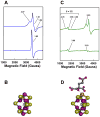Dual functions of NifEN: insights into the evolution and mechanism of nitrogenase
- PMID: 20221527
- PMCID: PMC3030252
- DOI: 10.1039/b922555b
Dual functions of NifEN: insights into the evolution and mechanism of nitrogenase
Abstract
Nitrogenase catalyzes the nucleotide-dependent conversion of dinitrogen to ammonia at the iron-molybdenum cofactor (FeMoco) center of its molybdenum-iron (MoFe) protein component. Biosynthesis of FeMoco is arguably one of the most complex processes in the field of bioinorganic chemistry, which involves the participation of a number of nif (nitrogen fixing) gene products. One key player in this process, NifEN (encoded by nifE and nifN), is homologous to the MoFe protein with regard to both the primary sequences and the types of the metal centers. Recently, an all-iron precursor has been identified on NifEN, which closely resembles the Fe/S core structure of the mature cofactor. Such a precursor-bound form of NifEN has not only served as an excellent platform for the investigation of FeMoco assembly, but also facilitated the examination of the capacity of NifEN as a catalytic homolog of MoFe protein. This perspective will focus on the recent advances toward elucidating the dual functions of NifEN in nitrogenase assembly and catalysis, and the insights afforded by these advances into the evolution and mechanism of nitrogenase.
Figures








Similar articles
-
Catalytic activities of NifEN: implications for nitrogenase evolution and mechanism.Proc Natl Acad Sci U S A. 2009 Oct 6;106(40):16962-6. doi: 10.1073/pnas.0907872106. Epub 2009 Sep 23. Proc Natl Acad Sci U S A. 2009. PMID: 19805110 Free PMC article.
-
Decoding the nitrogenase mechanism: the homologue approach.Acc Chem Res. 2010 Mar 16;43(3):475-84. doi: 10.1021/ar900254x. Acc Chem Res. 2010. PMID: 20030377 Free PMC article.
-
Formation of a homocitrate-free iron-molybdenum cluster on NifEN: implications for the role of homocitrate in nitrogenase assembly.Dalton Trans. 2010 Mar 28;39(12):3124-30. doi: 10.1039/c000264j. Epub 2010 Feb 18. Dalton Trans. 2010. PMID: 20221547 Free PMC article.
-
Assembly of nitrogenase MoFe protein.Biochemistry. 2008 Apr 1;47(13):3973-81. doi: 10.1021/bi7025003. Epub 2008 Mar 4. Biochemistry. 2008. PMID: 18314963 Review.
-
Biosynthesis of the iron-molybdenum cofactor of nitrogenase.Annu Rev Microbiol. 2008;62:93-111. doi: 10.1146/annurev.micro.62.081307.162737. Annu Rev Microbiol. 2008. PMID: 18429691 Review.
Cited by
-
Reconstruction of Nitrogenase Predecessors Suggests Origin from Maturase-Like Proteins.Genome Biol Evol. 2022 Mar 2;14(3):evac031. doi: 10.1093/gbe/evac031. Genome Biol Evol. 2022. PMID: 35179578 Free PMC article.
-
Crystal structure of VnfH, the iron protein component of vanadium nitrogenase.J Biol Inorg Chem. 2018 Oct;23(7):1049-1056. doi: 10.1007/s00775-018-1602-4. Epub 2018 Aug 23. J Biol Inorg Chem. 2018. PMID: 30141094
-
NifEN: a versatile player in nitrogenase assembly, catalysis and evolution.J Biol Inorg Chem. 2025 Mar;30(2):135-149. doi: 10.1007/s00775-024-02086-6. Epub 2024 Dec 12. J Biol Inorg Chem. 2025. PMID: 39663240 Review.
References
Publication types
MeSH terms
Substances
Grants and funding
LinkOut - more resources
Full Text Sources
Miscellaneous

